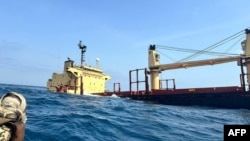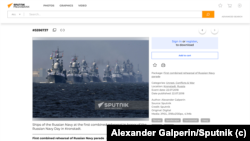On March 28, the U.S. Central Command (CENTCOM) said the U.S. military had destroyed four drones launched by Iran-backed Houthi rebels in Yemen.
CENTCOM said those drones were “aimed at a Coalition vessel and a U.S. warship” and “presented an imminent threat to merchant vessels and U.S. Navy ships” in the region.
Those attacks fit into a monthslong Houthi campaign to target commercial ships in the Red Sea and Gulf of Aden to show their solidarity with Hamas and opposition to Israel.
Sympathetic social media users, in turn, have repeatedly tried to exaggerate the success of those strikes.
Ships from the United States and United Kingdom remain in the Houthis’ crosshairs. The U.S. and U.K., with support from allies, maintain a presence in the Red Sea, and have conducted a series of joint strikes on the Houthis to degrade their ability to carry out what CENTCOM called “illegal and reckless attacks on U.S. and international vessels and commercial shipping in the Red Sea.”
By contrast, Bloomberg reported on March 21 that China and Russia may “provide political support to the Houthis in bodies such as the United Nations Security Council,” including by “blocking more resolutions against the group,” in exchange for safe passage through the Red Sea and Gulf of Aden.
Some social media users suggest that support may go further, insinuating that Russia and North Atlantic Treaty Organization (NATO) forces, which include the U.S. and the U.K., might clash in the region.
On March 28, verified X user Alex_Oloyede2, who regularly spreads pro-Kremlin disinformation, posted a photograph with nine naval vessels at sea, with the comment:
“BREAKING: Possible Sea Confrontation between Russia and NATO The Russian Pacific fleet has entered the Red Sea, making its way to the coasts of Yemen where multiple American and British ships carry out strikes against the Houthis.”
That post had received 2.6 million views, 29,000 likes and 7,300 reposts at the time of writing, and some variation of it has been shared by over a dozen accounts across X.
It has also been shared on TikTok.
However, the claim is misleading on a number of levels.
First, the photo is from 2018, and shows a rehearsal in Kronstadt, west of St. Petersburg, Russia, for the Russian Navy Day parade.
Unlike the photograph used by Alex_Oloyede2, which implies a more robust Russian naval presence, Russian media have confirmed that only two Russian vessels, the missile cruiser Varyag and the frigate Marshal Shaposhnikov, were dispatched to the Red Sea.
And those reports suggest the Russian ships, rather than confronting NATO, were engaged in training against the exact sort of attacks the Houthis have been launching.
On March 24, Zvezda, the Russian Defense Ministry’s official TV channel, reported that the Varyag and Marshal Shaposhnikov participated in “exercises to combat piracy in the waters of the Arabian Sea.”
Those exercises took place in the Gulf of Aden, which connects with the Red Sea through the Bab-el-Mandeb Strait.
According to Zvezda, “the crews practiced actions to repel a pirate attack on a merchant ship,” specifically “joint actions to destroy several unmanned boats and UAVs (unmanned aerial vehicles) of a mock enemy under conditions of a massive attack.”
Those exercises mirrored the forms of attacks the Houthis have launched against commercial vessels, and U.S. and U.K. warships, in the Red Sea.
Despite Russia’s strategic alliance with Houthi-patron Iran, the Houthis have reportedly struck a Chinese-owned and -operated oil tanker carrying Russian oil, as well as a Panama-flagged ship carrying Russian oil, in the Red Sea.
On March 28, Zvezda reported that the Varyag and Marshal Shaposhnikov had transited the Bab-el-Mandeb strait into the Red Sea “to carry out their assigned tasks as part of a long-distance sea voyage.”
There is no evidence suggesting a “possible sea confrontation between NATO and Russia.”
Russian and Iranian state media have regularly spread disinformation narratives intended to whitewash actions by the Houthi rebels while falsely portraying the United States as the party responsible for escalating hostilities in the Red Sea.
Accompanying this disinformation narrative, social media users have repeatedly spread the false claim that Russia has or could deploy its forces to intervene on behalf of the Palestinians, or aligned forces like the Houthis.
Since the Israel-Hamas war began on October 7, 2023, Polygraph.info has documented a number of social media posts using recycled footage or images to support false, misleading or otherwise unsubstantiated narratives about the conflict and related events in Yemen and the Red Sea.
In a January report, the European Fact-Checking Standards Network Project, a consortium of fact-checking and open-source intelligence (OSINT) organizations across Europe, said that X, formally known as Twitter, ranked “worst” in its efforts to fight disinformation.
An earlier 2023 investigation by NewsGuard, an information analysis company, found that blue-checked, “verified” X users like Alex_Oloyede2 and those who spread the same misleading claim, “are superspreaders of misinformation about the conflict, boosting falsehoods while displaying a ‘verification’ blue checkmark that verifies nothing.”








